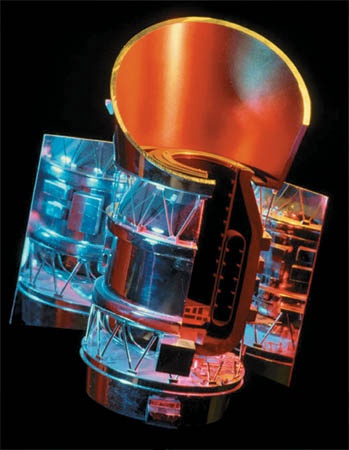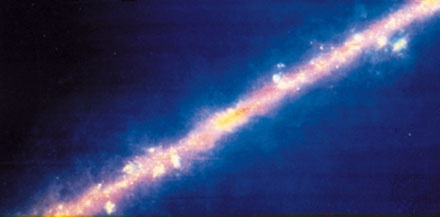Infrared Astronomical Satellite
astronomy
 U.S.-U.K.-Netherlands satellite launched in 1983 that was the first space observatory to map the entire sky at infrared wavelengths.
U.S.-U.K.-Netherlands satellite launched in 1983 that was the first space observatory to map the entire sky at infrared wavelengths.After a series of brief studies by infrared instruments carried on sounding rockets had detected about 4,000 celestial sources of infrared radiation, the United States, the United Kingdom, and The Netherlands built IRAS to map the sky at infrared wavelengths of 12, 25, 60, and 100 micrometres. It was launched on Jan. 25, 1983, on a Delta rocket from Vandenberg Air Force Base in California into a polar orbit at an altitude of 900 km (550 miles).
Its 60-cm- (24-inch-) diameter telescope was cooled by superfluid helium that chilled the structure down to 10 K (−263 °C, or −442 °F) and the detector to 2 K (−271 °C, or −456 °F). This was necessary because if the telescope were not cooled down, its own thermal radiation at infrared wavelengths would swamp the much fainter radiation from astronomical objects. During each orbit, IRAS scanned a strip of sky 30 arc minutes wide, and successive strips overlapped by 15 arc minutes to ensure that nothing was missed. On its first day of observations (Feb. 10, 1983), it doubled the number of known infrared sources. Its operational life was defined by the rate at which it consumed its coolant, and it had to be shut down on Nov. 21, 1983, by which time it had noted over a quarter of a million sources. Various preliminary data sets were released between 1984 and 1986, and these were then refined several times to produce the final IRAS Sky Survey Atlas, which was published in 1993.
 IRAS proved adept at discovering comets (it is credited as “discoverer” of six of them). It revealed that some young stars have disks of minute, solid dust particles, suggesting that such stars are in the process of forming planetary systems. IRAS also discovered many previously unknown galaxies that emit most of their energy in the infrared portion of the electromagnetic spectrum (these are known as ultraluminous infrared galaxies), apparently owing to a massive burst of star formation during the merger of two galaxies.
IRAS proved adept at discovering comets (it is credited as “discoverer” of six of them). It revealed that some young stars have disks of minute, solid dust particles, suggesting that such stars are in the process of forming planetary systems. IRAS also discovered many previously unknown galaxies that emit most of their energy in the infrared portion of the electromagnetic spectrum (these are known as ultraluminous infrared galaxies), apparently owing to a massive burst of star formation during the merger of two galaxies.- Mortier, Édouard-Adolphe-Casimir-Joseph, Duc De Trevise
- Mortillet, Gabriel de
- Mortimer Family
- Mortimer J. Adler
- Mortimer, Penelope
- Mortimer, Sir John
- mortmain
- Morton Feldman
- Morton Gould
- Morton, James Douglas, 4th Earl of
- Morton, Jelly Roll
- Morton, John
- Morton, J. Sterling
- Morton, Levi
- Morton National Park
- Morton, Oliver H. P.T.
- Morton Prince
- Morton, Sarah Wentworth Apthorp
- Morton, Thomas
- Morton, William Thomas Green
- mortuary temple
- morula
- Moruya
- Morvan
- Morvi